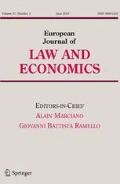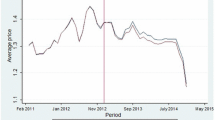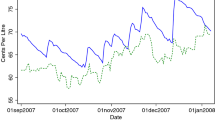Abstract
Difference-in-difference methods are being increasingly used to analyze the impact of mergers on pricing and other market equilibrium outcomes. Using evidence from an exogenous merger between two retail gasoline companies in a specific market in Spain, this paper shows how concentration did not lead to a price increase. In fact, the conjectural variation model concludes that the existence of a collusive agreement before and after the merger accounts for this result, rather than the existence of efficient gains. This result may explain empirical evidence reported in the literature according to which mergers between firms do not have significant effects on prices.

Similar content being viewed by others
Notes
In fact, Bougette and Turolla (2008) study what factors affect the probability to enhance merger remedies in European Commission´s decisions. High market power is a driver of this decision.
See Budzinski and Ruhmer (2010) for an in-depth explanation of merger simulation models and their application to competition policy.
Sapienza (2002) reported that the effect on loan contracts depended on the size of the banks involved in the merger deal. If the firms had a sizeable market share, interest rates rose; if they had a smaller market share, interest rates fell.
See Weinberg (2008) for a more detailed discussion of most of the above studies.
Sen and Townley (2010) evaluated the effects of reductions in outlet density on retail prices using Canadian data from 1991–1997. A 27 % decline in retail outlets led to a 9 % increase in retail prices. The authors also considered two mergers in this period but reported mixed, and not highly statistically significant, impacts on prices.
The Royal Decree 6/2000 was passed on 23 June.
In this sense, Brouwer (2008) states that EU merger analysis has changed to an efficiencies argument, while this is not the case. So, it should have been rejected.
Section 5 includes a more detailed explanation of the terminology of the variables used in the analysis.
Results from the pricing equations without Q as explanatory variables provide similar results.
Problems of multicollinearity are not found between the fixed effects of the month and the spot price of gasoline (the correlation ranges from −0.18 to 0.25) or between the fixed effects of island and transport costs (the correlation ranges from −0.42 to 0.61).
In fact, the report provided for the companies by the Tribunal (Expedient C86-04, footnote 105) affirms that (…) an increase in prices of less than 0.15 % could be expected because of the concentration.
Bertrand et al. (2004) results indicate that the DiD estimator may have a bias that leads to the null hypothesis of no effect being rejected when the error term is autocorrelated. While our results may also suffer from this bias, it would strengthen our findings that the merger has not had any significant effect on prices, even though autocorrelation might lead to such an effect being detected incorrectly.
If we follow the approximation of Dafny et al. (2012), where the difference-in-difference variables interact with the change in the HHI, the results do not change significantly. The results are available on request to authors.
The building of the structural model is fully summarized in Perdiguero and Jiménez (2009).
We introduced a cluster by island to take into account the fact that the error term could be different on each island. Our results remained constant however.
Corts (1999) shows how the conduct parameter method can underestimate the degree of market power if firms are involved in dynamic efficient collusion. In our case, the conduct parameter is near the monopoly level so if this bias exists it has only a very slight effect on our estimates. Various studies, including Puller (2009), propose different methodologies to solve this bias. Unfortunately they require firm-level data which we do not have access to.
References
Albalate, D. (2008). Lowering blood alcohol content levels to save lives: The European experience. Journal of Policy Analysis and Management, 27(1), 20–39.
Ashenfelter, O., & Hosken, D. (2008). The effect of mergers on consumer prices: Evidence from five selected case studies. Working paper no. 13859, National Bureau of Economic Research, Cambridge, Mass.
Barron, J., & Umbeck, J. R. (1984). The effects of different contractual arrangements: The case of retail gasoline markets. Journal of Law and Economics, 27, 313–328.
Barton, D., & Sherman, R. (1984). The price and profit effects of horizontal merger: A case study. Journal of Industrial Economics, 33, 165–177.
Bello, A., & Cavero, S. (2008). The Spanish retail petroleum market: New patterns of competition since the liberalization of the industry. Energy Policy, 36, 612–626.
Bertrand, M., Duflo, E., & Mullainathan, S. (2004). How much should we trust differences-in-differences estimates? The Quarterly Journal of Economics, 119, 249–275.
Blass, A., & Carlton, D. W. (1999). The choice of organizational form in gasoline retailing and the costs of laws limiting that choice. Working paper no. 7435, National Bureau of Economic Research, Cambridge, Mass.
Borenstein, S. (1990). Airline mergers, airport dominance, and market power. American Economic Review, 80, 400–404.
Borenstein, S., & Shepard, A. (1996). Dynamic pricing in retail gasoline markets. RAND Journal of Economics, 27, 429–451.
Bougette, P., & Turolla, S. (2008). Market structure, political surroundings, and merger remedies: An empirical investigation of the EC’s decisions. European Journal of Law and Economics, 25, 125–150.
Brouwer, M. T. (2008). Horizontal mergers and efficiencies; theory and anti trust practice. European Journal of Law and Economics, 26, 11–26.
Budzinski, O., & Ruhmer, I. (2010). Merger simulation in competition policy: A survey. Journal of Competition Law and Economics, 6(2), 277–319.
Chouinard, H., & Perloff, J. (2007). Gasoline price differences: Taxes, pollution regulations, mergers, market power, and market conditions. The B.E. Journal of Economic Analysis & Policy, 7, 1–26.
Coloma, G. (2002). The effect of the Repsol–YPF merger on the gasoline market. Review of Industrial Organization, 21, 399–418.
Connor, R. A., Feldman, R. D., & Dowd, B. E. (1998). The effects of market concentration and horizontal mergers on hospital costs and prices. International Journal of the Economics of Business, 5, 159–180.
Corts, K. S. (1999). Conduct parameters and the measurement of market power. Journal of Econometrics, 88, 227–250.
Dafny, L. S. (2009). Estimation and identification of merger effects: An application to hospital mergers. Journal of Law and Economics, 52, 523–550.
Dafny, J., Duggan, M., & Ramanarayanan, S. (2012). “Paying a premium on your premium? Consolidation in the US health insurance industry. American Economic Review, 102(2), 1161–1185.
Dahl, C., & Sterner, T. (1991). Analysing gasoline demand elasticities: A survey. Energy Economics, 13, 203–210.
Delpachitra, S. B. (2002). Price rigidity in the downstream petroleum industry in New Zealand: Where does it happen? Energy Economics, 24, 597–613.
Eckert, A., & West, D. (2005). Price uniformity and competition in a retail gasoline market. Journal of Economic Behavior & Organization, 56, 219–237.
Fageda, X. (2006). Measuring conduct and cost parameters in the Spanish air transport market. Review of Industrial Organization, 28, 379–399.
Focarelli, D., & Panetta, F. (2003). Are mergers beneficial to consumers? Evidence from the market for bank deposits. American Economic Review, 93, 1152–1172.
Hastings, J. (2004). Vertical relationships and competition in retail gasoline markets: Empirical evidence from contract changes in Southern California. American Economic Review, 94, 317–328.
Karikari, J. A., Brown, S., & Nadji, M. (2002). The Union Pacific/Southern Pacific railroads merger: Effect of trackage rights on rates. Journal of Regulatory Economics, 22, 271–285.
Kim, H., & Singal, V. (1993). Mergers and market power: Evidence from the airline industry. American Economic Review, 83, 549–569.
Lafontaine, F., & Slade, M. (2008). Exclusive contracts and vertical restraints: Empirical evidence and public policy. In Paolo Buccirossi (Ed.), Handbook of antitrust economics (pp. 319–414). Cambridge: MIT Press.
McCabe, M. J. (2002). Journal pricing and mergers: A portfolio approach. American Economic Review, 92, 259–269.
Parker, P., & Röller, L.-H. (1997). Collusive conduct in duopolies: Multimarket contact and cross-ownership in the mobile telephone industry. RAND Journal of Economics, 28, 304–322.
Perdiguero, J. (2010). Dynamic pricing in the Spanish gasoline market: A tacit collusion equilibrium. Energy Policy, 38, 1931–1937.
Perdiguero, J., & Jiménez, J. L. (2009). ¿Competencia o colusión en el mercado de gasolina? Una aproximación a través del parámetro de conducta. Revista de Economía Aplicada, 17(50), 27–45.
Peters, C. (2006). Evaluating the performance of merger simulations: Evidence from the U.S. airline industry. Journal of Law and Economics, 49, 627–649.
Prager, R. A., & Hannan, T. H. (1998). Do substantial horizontal mergers generate significant price effects? Evidence from the banking industry. Journal of Industrial Economics, 46, 433–452.
Puller, S. L. (2007). Pricing and firm conduct in California’s deregulated electricity market. Review of Economics and Statistics, 89(1), 75–87.
Puller, S. L. (2009). Estimation of competitive conduct when firms are efficiently colluding: Addressing the Corts critique. Applied Economics Letters, 16(15), 1497–1500.
Sapienza, P. (2002). The effects of banking mergers on loan contracts. The Journal of Finance, 57, 329–367.
Sen, A., & Townley, P. G. C. (2010). Estimating the impacts of outlet rationalization on retail prices, industry concentration, and sales: Empirical evidence from Canadian gasoline markets. Journal of Economics & Management Strategy, Fall, 19, 605–633.
Shepard, A. (1993). Contractual form, retail price, and asset characteristics in gasoline retailing. RAND Journal of Economics, 24, 58–77.
Simpson, J., & Schmidt, D. (2008–2009). Difference-in-Differences analysis in antitrust: A cautionary note. Antitrust Law Journal, 75, 623–34.
Simpson, J., & Taylor, C. (2008). Do gasoline mergers affect consumer prices? The Marathon Ashland petroleum and Ultramar Diamond Shamrock transaction. Journal of Law and Economics, 51, 135–152.
Taylor, C., & Hosken, D. (2007). The economic effects of the Marathon–Ashland joint venture: The importance of industry supply shocks and vertical market structure. Journal of Industrial Economics, 55, 419–451.
Taylor, C., Kreisle, N., & Zimmerman, P. R. (2007). Vertical relationships and competition in retail gasoline markets: Comment. Working paper no. 291, Federal Trade Commission.
Vita, M. G. (2000). Regulatory restrictions on vertical integration and control: The competitive impact of gasoline divorcement policies. Journal of Regulatory Economics, 18, 217–233.
Vita, M. G., & Sacher, S. (2001). The competitive effects of not-for-profit hospital mergers: A case study. Journal of Industrial Economics, 49, 63–84.
Weinberg, M. (2008). The price effects of horizontal mergers. Journal of Competition Law & Economics, 4, 433–447.
Acknowledgments
Thanks are due to Albert Banal, Joan-Ramón Borrell, Javier Campos, Andrés Gómez-Lobo, Daniel Hosken, Consuelo Pazó, George Symeonidis and an anonymous referee for their helpful comments. The usual disclaimer applies.
Author information
Authors and Affiliations
Corresponding author
Rights and permissions
About this article
Cite this article
Jiménez, J.L., Perdiguero, J. Mergers and difference-in-difference estimator: Why firms do not increase prices?. Eur J Law Econ 45, 285–311 (2018). https://doi.org/10.1007/s10657-014-9437-0
Published:
Issue Date:
DOI: https://doi.org/10.1007/s10657-014-9437-0




